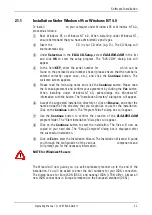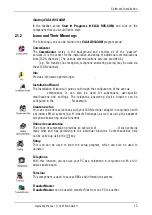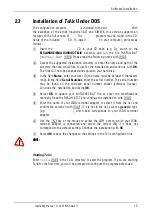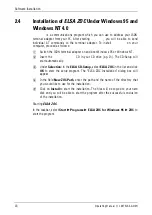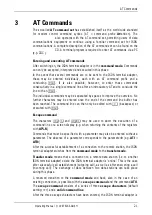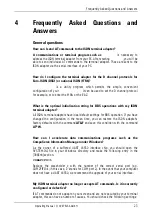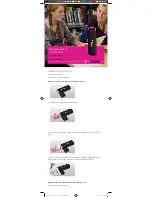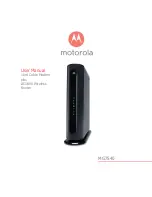
Frequently Asked Questions and Answers
24
ELSA TanGo 1000
Operating Manual © 1997 ELSA GmbH
n
Is your ISDN terminal adapter connected to the serial interface (COM port)
specified in the settings of your communications software? You can determine
the IRQ of your serial interface with the program
ELSA ISDNconfig
.
n
If the configuration of your ISDN adapter is incorrect, try to restore the default
settings with the command
AT&F
, even if the command isn't displayed on the
screen when entering it. In this condition is should be possible to enter an AT,
to which the ISDN adapter will return an
OK
.
Can I reach a Euro-ISDN (DSS1) remote station from a 1TR6 connection or
vice versa?
The differing connection types or D channel protocols are not relevant in this case,
as these are only significant for the communications between your ISDN connection
and the local exchange. A connection can be established even if both sides are
using different D channel protocols.
When Up and downloading from/to BBS systems, a large number of CRC
errors result; in some cases the connection is even aborted. What are the
possible reasons?
CRC errors can have a variety of reasons. A possible cause is an incorrectly-set or
missing handshake process. In order to take proper advantage of data compression,
the speed on the computer side should be set higher than on the telephone side
(e.g. 115,200 bps instead of 64,000 bps). This, however, requires either a hardware-
(RTS/CTS) or software-based (XON/XOFF) handshake process.
These processes must be set up identically in the software as well as in the ISDN
terminal adapter. If this is not the case, CRC errors can result during data transfer. If
you use RTS/CTS handshaking, the V.24 connection can also be the cause. When
using a so-called mouse adapter (V.24 adapter from 25 to 9 pins), it is also possible
that the RTS and CTS conductors (Pin 4 und 5) in the adapter are not connected. One
should always ensure that V.24 cable adapters are fully wired for this reason.
The serial port of your computer can be a further source of errors. The use a type
16550 UART chip is advisable for speeds of 19,200 bps and higher under DOS and
for general use under Windows and OS/2. This UART has a 16 byte FIFO buffer which
permits significantly higher transfer speeds. Type 8250 and 16450 chips only
function reliably at speeds of up to 9600 bps; individual characters can be lost in the
interface at speeds of 19,200 bps upwards, leading to CRC errors.
Why do I always get CRC errors with my ISDN terminal adapter during
ZModem downloads at 115,200 bps, even though I'm using a UART 16550
with FIFO in my COM port? The throughput for CONNECTs at 28,000 bps is
only around 3000 cps.
The poor throughput is the result of the large number of CRC errors. Check the BIOS
settings of your computer and ensure that
IDE HDD BLOCK MODE
is set to
DISABLED
.
Summary of Contents for TanGo 1000
Page 1: ...ELSA TanGo 1000 User Manual ...
Page 6: ...Table of Contents 4 ELSA TanGo 1000 Operating Manual 1997 ELSA GmbH ...
Page 10: ...Introduction 8 ELSA TanGo 1000 Operating Manual 1997 ELSA GmbH Notes ...
Page 22: ...Software Installation 20 ELSA TanGo 1000 Operating Manual 1997 ELSA GmbH Notes ...


